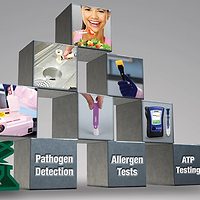Addressing Environmental Monitoring Myths for Easy EMP

As food safety philosophy shifts from reaction towards prevention, demand is increasing for rapid, accurate and cost-effective tools to monitor the efficacy of preventive control programs. Food manufacturing facilities of all sizes are starting up or strengthening environmental monitoring programs (EMP) as a means of verification that preventive controls are working to minimize the risk of cross-contamination or harborage of such pathogens as Salmonella or Listeria.
Processors are motivated to bring environmental sample analysis on-site to cut costs, improve time to results and gain better control and insight into environmental conditions. However, most methods of analysis in the marketplace are prohibitive, requiring a full library of laboratory equipment or specialized PCR analysis machinery. Lab managers must accommodate all the necessary tools, equipment and accessories for sample collection, mixing and measurement of media, sample containment, incubation and the actual test kit or device for microbiological analysis. Even the simplest “ready-to-use” plating media require sponges, broth, pipettes, pipette tips and an incubator in addition to the plate. For many processors new to environmental monitoring, it may seem the options for accomplishing environmental testing are thus limited to two extremes: (1) sending samples to an outside lab or (2) a building a Biosafety Level 2 facility for in-house analysis using FDA or USDA protocols. A critical goal of a pathogen EMP is to seek and destroy–and when sampling is cost-prohibitive, the intention of a comprehensive program is jeopardized. After all, you can’t manage what you don’t measure.
In selecting an alternative rapid testing method, regulatory guidance encourages the use of methods with equivalent or greater sensitivity for detecting Listeria species than ISO or FDA BAM methods, validated by a third party such as AOAC and/or supported by rigorous internal validation. A simple validated method features chromogenic media in a self-contained, all-in-one test device–Hygiena’s InSite for Listeria species or Salmonella. InSite Listeria and InSite Salmonella are ready-to-use environmental test devices for presumptive identification or Listeria species or Salmonella species in 24–48 hours. Featuring a large foam sampling swab and pre-measured AOAC-RI validated media, Hygiena’s InSite test devices reduce time to results by several days and have proven to outperform traditional methods.
Validation studies have measured no significant difference between Hygiena InSite Listeria and the USDA Listeria method. InSite Listeria detects 1–100 Listeria spp. in 24 hours, giving results an entire day earlier than the standard method, and is simpler and easier to use. In another study, no statistically significant difference was found between Hygiena’s InSite Salmonella method and the FDA BAM method. InSite Salmonella was found to be as sensitive as the reference method in all surfaces studied. In fact, it was slightly more sensitive than the reference method in stainless steel surface comparison studies. Furthermore, InSite Salmonella features 24–48-hour results in two steps, whereas the FDA-BAM method requires several incubation and enrichment steps over 3–5 days.
Another common misconception about environmental monitoring is the notion that a large sampling device and swabbing area are prerequisites to effectively recovering and identifying environmental contamination. However, the probability of detecting sporadic and irregularly distributed contamination is addressed more effectively by increasing the number and zone range of samples rather than increasing the surface swab area in fewer locations. In a laboratory study, Hygiena has proven that increased sampling area and sample collection device surface area are not nearly as influential in identifying contamination as the performance of the selective media.
To test swabbing efficiency and pickup, it is more accurate to measure what is left behind on a surface rather than attempt to measure what is collected by the swabbing device. In a laboratory study, Hygiena measured bacteria left behind after sampling as an inverse representation of sample collection efficiency. Common sampling area sizes included in the study are 4” x 4” and 12” x 12”. The results of all experiments demonstrate swabbing with Hygiena test devices is more efficient than commonly used contact plates for sampling bacteria from surfaces. InSite swabs achieve 97% pickup from a 4” x 4” area and 91% efficiency from a 12” x 12” area. A larger sampling area transfers a larger proportion of the swabbing solution from the swab onto the environmental surface; however, this does not significantly affect test results. Swabbing the 4” x 4” area with InSite transfers 13% of swabbing solution volume to the surface; swabbing a 12” x 12” area transfers 29% from the swab. However, this loss in swabbing solution does not have a significant effect on the growth and recovery of low-level bacteria in InSite test devices.
Bringing environmental monitoring in-house for Listeria and Salmonella testing is not so out-of-reach for small- and medium-sized food processors. Learn more about Hygiena InSite test devices at www.hygiena.com or contact Technical Support for more information about the studies discussed in this article.
www.hygiena.com
>
Looking for a reprint of this article?
From high-res PDFs to custom plaques, order your copy today!








